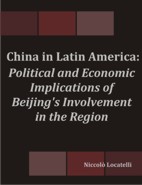LibrarySocial SciencesEconomics
China in Latin America
Political and Economic Implications of Beijing's Involvement in the Region
| Institution: | University of Bologna |
|---|---|
| Advisor(s): | Prof. Loris Zanatta |
| Degree: | M.A. in International and Diplomatic Science |
| Year: | 2010 |
| Volume: | 157 pages |
| ISBN-10: | 1599423901 |
| ISBN-13: | 9781599423906 |
Abstract
Relations with Latin America have never been and will probably never be a priority for the People's Republic of China (PRC), as they will be a dependent variable of domestic economic needs and other more important foreign policy goals – among all, the ties with the United States. During the first forty years of existence, geopolitical and economic considerations (Latin America was considered to be Washington's backyard and the economies of the region were not complementary with that of China) were keeping the PRC away from the area; nevertheless, things have changed ever since the end of the Cold War, and more so since the new millenium.
The PRC finds in Latin America a market of 500 million people and an almost infinite source of commodities: it currently gets from here around 17% of its overall agricultural products imports, and 11% of its fuel and mining ones. It is a big buyer of three of the four Latin American commodities (soy, copper and oil) and it's increasing its purchases of the fourth, coffee. The region is also a valuable partner in the struggle for a new world order, more democratic and more concerned with the stakes of the developing countries; it is a 33-wide voting block whose consensus is useful whenever the human rights policy of the PRC comes under the scrutiny of the United Nations or any of its agencies. Finally, Latin America is a pawn in the battle for the sovereignty over Taiwan, since 12 of the 23 countries that recognize the Republic of China (ROC) are in the area, mainly in Central America and the Caribbean, plus Paraguay alone in South America.
For Latin America, the PRC is a huge 1.3 billion people market and a potential source of much-needed Foreign Direct Investment, which in actuality turns out to be smaller than expected and mostly concentrated in the fiscal heavens of the Caribbean. Politically, besides the partnership in the struggle for a new world order, the mere existence of a China-option is itself a source of leverage when Latin American countries have to deal with the United States, who now have to face a competitor on trade and politic issues in what used to be their backyard.
Apparently, deepening ties with Latin America is a winning solution for the PRC. The same is not completely true for Latin America, whose relationship with Beijing can be beneficial, but with some caveats. As far as bilateral trade is concerned, the problem is that of export concentration: in 2006, 62.5% of the region's exports to China were in the commodity sector - it was just 35% in 1995. This leaves Latin America, especially South America, exposed to the price volatility of its resources, which is historically more elevated than that of the manufactured goods and breeds macroeconomic uncertainty in a region that has always struggled with that issue. Furthermore, export concentration in the commodity sector, as far as the terms of trade are favorable as in the years before the ongoing global crisis, might hinder the upgrading of the industrial structure of those countries who find in it an easy and quick source of revenues. A positive effect on the welfare of the people and the fight against poverty and inequality is not automatically related to the blossoming of exports of natural resources, but depends on economic policy choices. A more recent, less studied aspect of Sino-Latin American trade is the increasing penetration of Chinese manufactured goods in the domestic markets of the region: while initially outplacing foreign competitors, the flow is becoming a source of concern for businesses in the textile sector of countries like Argentina, Brazil, and Mexico, who find it hard to compete with the minimum cost of labor that makes Chinese goods so cheap. That explains why the region has tariffs on imports from the Middle Kingdom that are 10% above world average (20% in the case of South America).
Competition with Chinese manufactures in the third markets is also Central America's main problem in its relationship with the Dragon. A review of the literature conveys the idea that the trend, especially as far as the U.S. market is concerned, is growing but not alarming; nevertheless, data collected for the first half of the current decade might not show the full effect of two cornerstones: the PRC's admission in the WTO in 2001 and the end of the Agreement on Textile and Clothing (that set a quota on developed countries' imports from the developing countries in that sector) in 2005. Transportation costs offset only about 1/3 of China's competitive advantage, and Latin America has to greatly improve its infrastructure in order not to lose additional market shares.
Henry Kissinger once said that history has never been produced in the South. Some decades later, the People's Republic of China is proving him wrong. All the caveats detailed in this thesis notwithstanding, Latin America can harness its relationship with the PRC to prove him wrong again.

